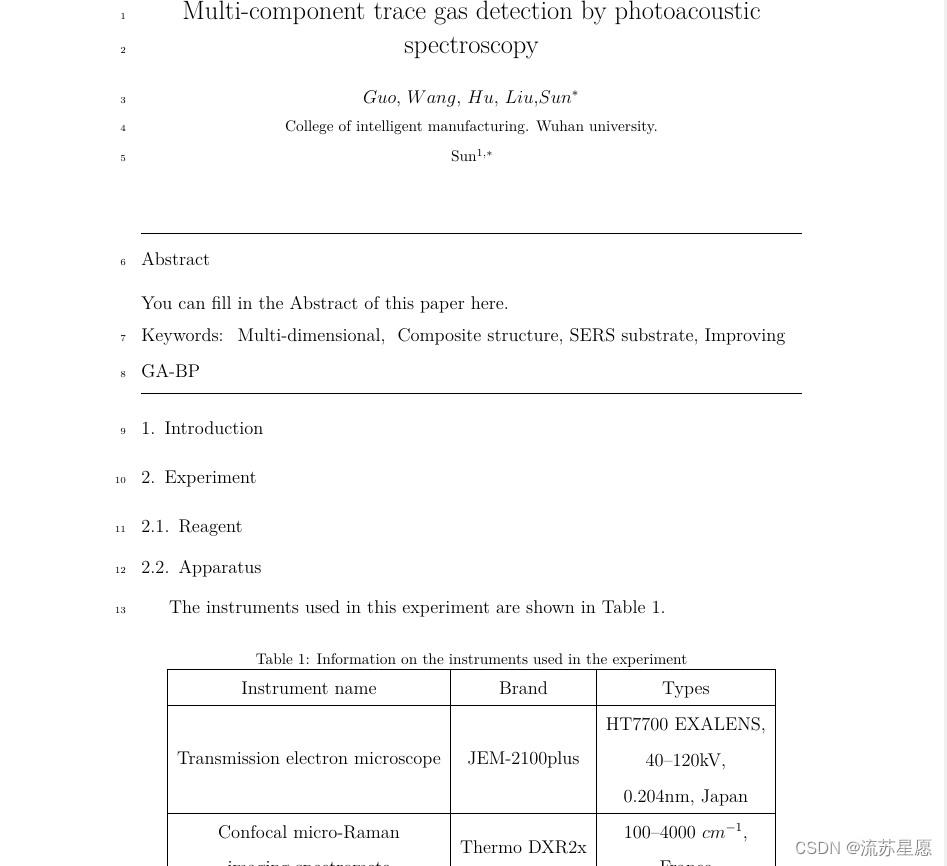一、Introduction
LateX基础操作参考:latex各个模块范例模板以及各种使用技巧_latex \big-CSDN博客
二、SCI论文的Elsevier latex模板
\documentclass[preprint,12pt]{elsarticle}
\usepackage{lineno,hyperref}
\modulolinenumbers[5]
\usepackage{amssymb}
\usepackage{algorithm}
\usepackage{algorithmic}
\usepackage{epsfig}
\usepackage{subfigure}
\usepackage{multirow}
\usepackage{float}
\usepackage{amsmath}
\usepackage{longtable}
\usepackage{booktabs}
\usepackage{color}
\usepackage{subfigure}
\usepackage{fancyhdr}
\usepackage{epstopdf}
\pagestyle{fancy}
\usepackage{ulem}
\usepackage{bm}
\usepackage{amsopn}
\usepackage{amssymb,amsmath,color,times}
\usepackage{lineno}
\usepackage{subfigure}
\usepackage{graphicx}
\usepackage{makecell}
\linespread{1.6}
\usepackage[bottom=1.2cm]{geometry}
\newcommand{\tabincell}[2]{\begin{tabular}{@{}#1@{}}#2\end{tabular}}
\renewcommand{\algorithmicrequire}{\textbf{Input:}}
\renewcommand{\algorithmicensure}{\textbf{Output:}}
\newcommand \argmin{\operatorname{arg\,min}}
\newcommand{\pder}[2][]{\frac{\partial#1}{\partial#2}}
\newcommand\R{\mathbb{R}}
\newcommand{\llambda}{\boldsymbol{\lambda}}
\newcommand{\sign}{{\mbox{\rm sign}}}
\fancyhead[R]{\footnotesize\it\leftmark}
\fancyhead[L]{\footnotesize\it\rightmark}
\bibliographystyle{model5-names}
\journal{ACS}%此处替换成你所投的期刊名
\begin{document}
\modulolinenumbers[1]
\linenumbers
\begin{frontmatter}
%% Title, authors and addresses
\title{Multi-component trace gas detection by photoacoustic spectroscopy\tnoteref{mytitlenote}}%论文名称
%% Group authors per affiliation:
\author{$Guo$, $Wang$, $Hu$, $Liu$,$Sun^{*}$}%论文作者
\address{College of intelligent manufacturing. Wuhan university.}%单位
\date{} %日期,一般空着
\author[mysecondaryaddress]{Sun\corref{mycorrespondingauthor}}%通讯作者
\cortext[mycorrespondingauthor]{Sun}
\ead{123456@163.com}%通讯作者邮箱
%\address[mymainaddress]{1600 John F Kennedy Boulevard, Philadelphia}
%\address[mysecondaryaddress]{360 Park Avenue South, New York}
\begin{abstract}
You can fill in the Abstract of this paper here.
\end{abstract}
\begin{keyword}
\texttt{Multi-dimensional}\sep \ Composite structure\sep SERS substrate \sep Improving GA-BP
\end{keyword}
\end{frontmatter}
%% main text
\section{Introduction}%(\section{}表示论文的大章节)
\section{Experiment}
\subsection{Reagent}%(\subsection{}表示论文的小章节)
\subsection{Apparatus}
The instruments used in this experiment are shown in Table 1.
\begin{table}[htbp]
\centering
\caption{Information on the instruments used in the experiment}%表格题目
\begin{tabular}{|c|c|c|}%表示建立一个3列的表格,如果表格内容过长导致显示不全,可使用\makecell{A \\ B\\ C}指令来换行
\hline
Instrument name & Brand & Types \\
\hline
Transmission electron microscope & JEM-2100plus & \makecell{HT7700 EXALENS, \\ 40--120kV, \\ 0.204nm, Japan} \\
\hline
\makecell{Confocal micro-Raman \\imaging spectromete} & Thermo DXR2x & \makecell{100--4000 $cm^{-1}$, \\ France} \\
\hline
\end{tabular}
\end{table}
\section{Results}
%\begin{figure}[htbp] %%插入图片
%\centering %%居中处理
%\includegraphics[width=0.8\textwidth]{Fig9.png} %%图片大小及来源
%\caption{SERS signals of CNTs/Ag/AgNWs/SiO2 substrate at five different positions} %%图片名称
%\label{fig9}
%\end{figure}
%公式处理
\begin{equation}
RSD= \sqrt \frac{\sum_{i=1}^n (x_i-x)}{n-1}\frac{1}{x} \\ \label{Eq.3}
\end{equation}
\section{Evaluation and discussion}
\section{Conclusions}
\section*{Acknowledgment}
The research was funded by ministry of land and resources industry public welfare projects (No: 201511010-06).
\section*{References}
\begin{thebibliography}{33} %此处表示参考文献的数量,只多不少
\bibitem{ref1}Moskovits M. Enhanced Raman scattering by molecules adsorbed on electrodes--a theoretical model[J]. Solid State Communications, 1979, 32(1):59-62.
\bibitem{ref2}Garrido C, Boris E Weiss-López, Vallette M M C. Surface-enhanced Raman scattering activity of negatively charged bio-analytes from a modified silver colloid[J]. Spectroscopy Letters, 2016, 49(1):11-18.
\end{thebibliography}
\end{document}
\endinput
三、运行结果展示


四、结束语
本人的第一篇CSDN博客,希望对正在发SCI论文的你有所帮助。加油!






















 592
592

 被折叠的 条评论
为什么被折叠?
被折叠的 条评论
为什么被折叠?








